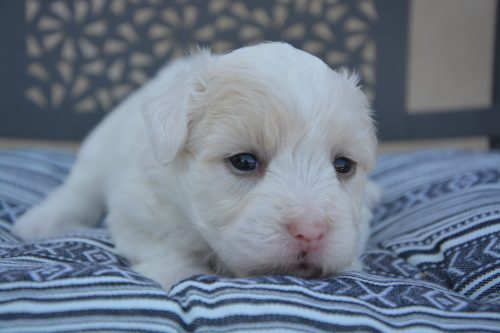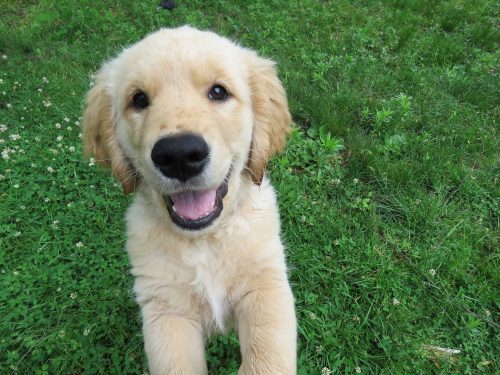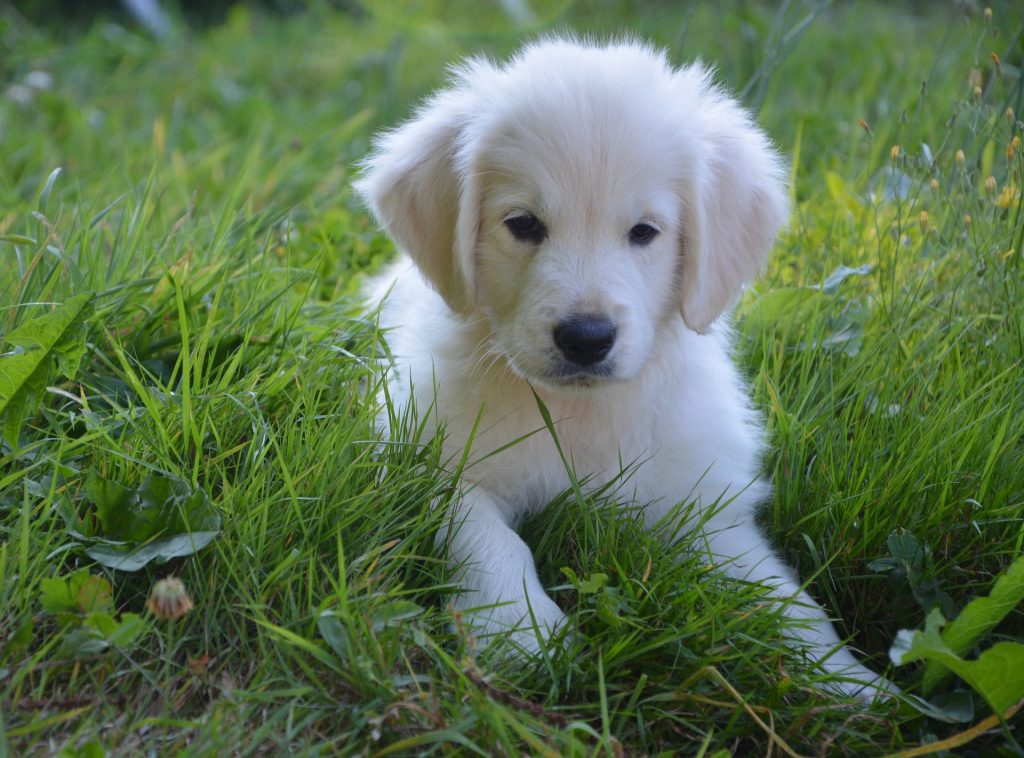Giardia in puppies and dogs is an infection of the intestines. It’s one of the most common intestinal parasites in both dogs and humans. Typically, the infection occurs in the small intestine. It is caused by a single-celled organism called a protozoan parasite.
Note that giardia must be ingested to cause an infection, whether by something consumed through the mouth or because the cysts are inhaled through the nose when your pup accidentally sniffs something that is contaminated.
This parasite’s name is giardia duodenalis and has seven different genotypes, labeled A through G. The ones that most often affect puppies are the genotype C and D.
This parasitic organism is not the same thing as a bacterium, a virus, or a worm. It is a worldwide parasite that can infect both animals and humans alike. Humans who become ill with something called “Travelers Diarrhea” can attribute their condition to the giardia parasite.
Puppies with a giardia infection may or may not show any symptoms. If they do, the most common one is diarrhea and less frequently, vomiting. The giardia organism is very hardy in its cystic form, which is the form that is shed by feces and then transmitted to puppies through contaminated food, water, and even grass and dirt if your puppy chews or eats it.
The other form of giardia is the feeding form, which is what lives in your puppy’s intestinal tract and his gut. This form of the organism is called a trophozoite. It is only when giardia is in cystic form that it can survive outside of its host, typically in cool and wet environments.
Causes of Giardia in Puppies

A giardia infection in puppies occurs when the pup swallows or sniffs the parasite while it is in cyst form from some kind of contaminated source. This can include food, drinking water, dirt, grass, and from close contact with other animals that may be carrying the parasite.
In dogs with compromised immune systems, or (as in the case of puppies) with underdeveloped immune systems, these cysts can pass through the dog’s intestinal tract and be transformed into the feeding form, a trophozoite.
In trophozoite form, the parasite will attach to your puppy’s intestinal wall to eat. As it eats, this parasite divides and multiplies, and can cause serious damage to the intestinal wall. When this happens, your pet will begin to display clinical signs of infection.
As the parasite multiplies and divides, it also transforms itself into new cysts that eventually your pup will defecate out, to transmit and infect another host. The life cycle of giardia in dogs from ingesting it in cyst form to defecating it back out in cyst form is thought to be roughly 5-12 days.
Sometimes the giardia organism can be found in a dog’s stool and pose no health issue at all. However, in puppies, it’s an entirely different matter. In puppies, the giardia infection can cause very virulent diarrhea, and if not treated right away, it can be fatal.
Giardiasis is quite common in compact, highly populated environments. Animal shelters, kennels, and pet stores all pose a risk and increase the likelihood of a potential giardia infection via fecal contamination. It is thought that up to half the population of young puppies will contract giardiasis at some point, due to their less-developed immune systems.
Signs of Giardia in Puppies
Giardia is often asymptomatic, especially in older dogs. Your pup may not display any discernible signs that something is wrong, either, although clinical signs are more common and discernible in puppies.
If he does display symptoms, it will most likely be diarrhea as well as some possible vomiting. Because the giardia parasite makes it difficult for your pup to process his food properly, it can cause mucus to sometimes be mixed with blood in the stool.
Giardia can also cause your pup’s stool to be foul-smelling. Sometimes it may be watery, sometimes it may just be soft, and on other occasions it could have a green tinge to it. You will most likely notice your pup’s coat seems less lustrous than before, and his little tummy may look bloated and swollen from gas.
Pups with a giardia infection also might struggle with gaining or maintaining weight. A pup suffering from diarrhea may have a sudden onset or experience chronic and sporadic diarrhea.
Often, giardia goes undiagnosed because of the nature of the symptoms. Most pet owners just think their pup got into something that didn’t agree with him, and wait for the episode to pass. A pup that goes a long time undiagnosed with giardia can lose quite a bit of weight, and even experience lasting damage to his intestinal lining. Unfortunately, this can cause secondary health issues, such as inflammatory bowel disease, malabsorption, and chronic G.I. inflammation.
Risk Factors of Giardia in Puppies
- Cramped and tightly populated living quarters, such as kennels and shelters.
- Contaminated water, especially water from outdoors.
- Puppies and older dogs are at higher risk than adult dogs.
- Also, smaller dog breeds tend to be more susceptible to giardia than bigger dog breeds, perhaps because of their more delicate constitutions.
Preventing Giardia in Puppies
Try to avoid walking your pup outside where other animals go to the bathroom, whenever possible. Make sure your puppy has clean drinking water from indoors, and don’t let him drink from puddles or other outdoor sources.
Don’t allow him to drink from toilets either. Unfortunately, giardia is often found in tap water, so it pays to be careful. It may be prudent to have your tap water tested for the giardia parasite, and if it’s found, invest in a specialized water filter to keep your household water source clean and parasite-free.
Avoid places like pet stores and grooming houses, at least until your pup is older and his immune system is stronger. If you do go to a pet store, don’t let your pup drink from any communal water bowls.
It’s also very important to keep your pet out of kennels and boarding houses, where he may be surrounded by multiple other animals. If you do choose to board him, try to wait until he is at least a year old before doing so.
Make a strong effort to keep your yard clean of feces by picking up after your dog each time he goes. Unfortunately, grass and standing water is difficult to keep contamination-free, but you can keep surfaces clean and sanitized to help mitigate giardia transmission.
If possible, let your dog use the bathroom on a surface that can be properly sanitized. If that’s not possible, an alternative option might be to use puppy training mats, so that all messes can be cleaned up completely as they occur. Keeping your pup’s environment clean and parasite-free is vital to helping him overcome a giardia infection, and preventing it from coming back.
Diagnosing Giardia in Puppies
Diagnosing a giardia infection accurately isn’t easy. There are a variety of methods that can be used, some of which are more effective than others. Note that you will not be able to diagnose your dog yourself. The giardia organism is microscopic, and is invisible to the naked eye, thus making it only viewable with the proper equipment.
Fecal float testing (a smear of your dog’s stool that is tested for the presence of cysts) can be done in some cases. However, because giardia doesn’t shed itself in every stool sample, it can easily be missed if your dog is only tested once.
To gain a definitive diagnosis, your pup may need to be tested several times, and even then, the test results can be iffy.
Another option that appears to be more reliable is the fecal ELISA test, that actually checks for giardia antigens in your puppy’s body. With the fecal float test, your pup is only being tested for giardia cysts in the stool.
Though it’s being used more and more often, not all vets use this test, so you may have to request it. Some vets tend to rely solely on fecal flow tests, which is unfortunate, as you could do your pup a disservice by relying on these tests and missing a giardia infection altogether.
Treatment of Puppy Giardia
Just like diagnostic options, with giardia there are also multiple treatment options. These treatment options come with protocols that can last anywhere from 2 to 10 days. Medication commonly prescribed includes Flagyl and fenbendazole. Flagyl is a drug that was commonly used to treat giardia, but it only has a 60% to 70% success rate in curing the infection. It also poses some pretty nasty side effects, and isn’t recommended in dogs that are pregnant. This means that giving it to your puppy is probably not the best choice, either.

An option that is a bit safer for pups (although they still need to be at least six weeks or older), is fenbendazole. This is a drug that has been approved for treating things like hookworm, roundworm, and whipworm.
Because there aren’t currently any drugs on the market that are specifically approved for treating giardiasis, fenbendazole tends to be the most popular, and currently has no reported side effects.
Though some vets may recommend treating for giardia just in case, there are always risks to any medication and treatment. Giving your pup unnecessary medications is never a good idea.
Your vet will likely request that additional fecal exams be performed after a few weeks on the medication, to make sure the meds are working and that the infection is clearing.
It should be noted that follow-up testing is especially important these days, as giardia is becoming drug resistant to many of the common medications used to treat it. This makes it harder to get rid of, and makes the number of dogs that are positive carriers of the parasite go up.
When it comes to puppies in kennels and shelters, for treatment to be effective, you will need to clean and medicate all of the animals in the shelter, as well as decontaminate and clean all surfaces. It’s a good idea to wash all bowls, toys, and food containers in a high temperature dishwasher, or boil them all as well.
If you have carpet, you should steam clean it along with any furniture, especially furniture your pup may have touched or laid on. Disinfect hard surfaces using a bleach solution or other disinfecting product. It’s important to disinfect your pup’s environment thoroughly, because the environment is one of the top reasons an infection reoccurs.
A final (and necessary) step is to bathe the puppy thoroughly on the last day of treatment, in order to remove all fecal matter and any cysts that may be hiding out in his fur. You will want to focus especially on the anal area, but do that last to avoid possible recontamination of your pup’s fur.
Can Humans Get Giardia from Puppies?
Unfortunately, giardia can in fact be passed from pup to human. Fortunately, it’s not very common. This is especially true if you follow basic hygiene recommendations, such as washing your hands with warm, soapy water after handling your pup.
So, if your pup is infected, you could have family members that have also been infected… but in most cases, it’s not very likely.
Sources:
- Donna, Spector. “Giardia in Dogs: Learn About Symptoms and Treatment.” Vetstreet, 16 Sep. 2017. www.vetstreet.com/our-pet-experts/be-on-guard-against-giardia.
- Ward, Ernest. “Giardia in Dogs.” VCA, 16 Sep. 2017. www.vcahospitals.com/know-your-pet/giardia-in-dogs.
- Shojai, Amy. “How to Treat Giardia in Puppies.” The Spruce Pets, Accessed 16 Sep. 2017. www.thesprucepets.com/giardia-in-puppies-2804930.
- Burke, Anna. “The Facts You Need to Know About Giardia in Dogs.” American Kennel Club, 12 Sept. 2016, Accessed 16 Sep. 2017. www.akc.org/expert-advice/health/the-facts-you-need-to-know-about-giardia-in-dogs/.
- “Giardia | Don’t Let This Parasite Ruin Your Pet’s Health.” Healthy Pets, Accessed 16 Sep. 2017. www.healthypets.mercola.com/sites/healthypets/archive/2012/03/19/giardia-infection-on-pets.aspx.





